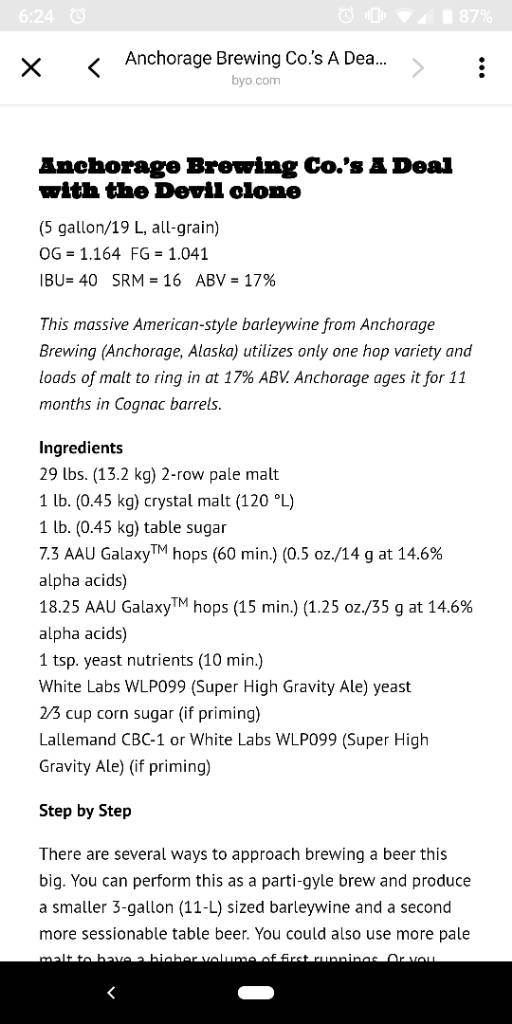I'd like to clone Anchorage Brewing's A Deal With The Devil.
It was reviewed in the Dec-Jan 2019 Beer and Brewing. Page 89. It received a score of 100/100.
======================================================================
"What the brewer says: Barleywine brewed with Galaxy hop, a starting gravity of 37 Plato, double oak, aged 10 months in Cognac barrels, 5 months in Woodford Reserve double oak barrels."
"What our panel thought:
Aroma Vanilla, Toffee, carmel, semi sweet chocolate, leather and tabacco. Spicy phenols, Candied orange peel and fig. Burnt maple syrup and maybe just a bit of wine grape.
Flavor: Carmel, toffee, vanilla, maple, bittersweet chocolate. Sweet, but balanced. Boozy and warming, but not harsh. Fairly viscous for style, full bodied. Pleasant oak notes of bourbon, sherry, port. Finishes sweet, but not cloying.
Overall: A wonderfully complex, full-bodied, sweet, big and delicious barley wine. Well balanced and beautifully boozy. An exquisite beer that begs to be savored.
========================================================================
Apparently there is a clone recipe in Brew Your Own, January 2018. I let my subscription lapse, so I don't have it. https://byo.com/recipe/anchorage-brewing-co-s-deal-devil-clone/
Brewer's Friend has the recipe here: https://www.brewersfriend.com/homeb...rage-brewing-co-s-a-deal-with-the-devil-clone
The OG doesn't scare me. I'll do it as a reiterative mash.
The recipe lists the mash temp as 64C, which is 147.2F. Really low, so it is very fermentable ? Also calls for White Labs Super High Gravity Ale Yeast WLP099. I assume this would need a big starter, plus oxygen to finish ? 18.3 to 20.6C is room temperature, basically.
How would one age it ? Without a whiskey barrel ?
It was reviewed in the Dec-Jan 2019 Beer and Brewing. Page 89. It received a score of 100/100.
======================================================================
"What the brewer says: Barleywine brewed with Galaxy hop, a starting gravity of 37 Plato, double oak, aged 10 months in Cognac barrels, 5 months in Woodford Reserve double oak barrels."
"What our panel thought:
Aroma Vanilla, Toffee, carmel, semi sweet chocolate, leather and tabacco. Spicy phenols, Candied orange peel and fig. Burnt maple syrup and maybe just a bit of wine grape.
Flavor: Carmel, toffee, vanilla, maple, bittersweet chocolate. Sweet, but balanced. Boozy and warming, but not harsh. Fairly viscous for style, full bodied. Pleasant oak notes of bourbon, sherry, port. Finishes sweet, but not cloying.
Overall: A wonderfully complex, full-bodied, sweet, big and delicious barley wine. Well balanced and beautifully boozy. An exquisite beer that begs to be savored.
========================================================================
Apparently there is a clone recipe in Brew Your Own, January 2018. I let my subscription lapse, so I don't have it. https://byo.com/recipe/anchorage-brewing-co-s-deal-devil-clone/
Brewer's Friend has the recipe here: https://www.brewersfriend.com/homeb...rage-brewing-co-s-a-deal-with-the-devil-clone
The OG doesn't scare me. I'll do it as a reiterative mash.
The recipe lists the mash temp as 64C, which is 147.2F. Really low, so it is very fermentable ? Also calls for White Labs Super High Gravity Ale Yeast WLP099. I assume this would need a big starter, plus oxygen to finish ? 18.3 to 20.6C is room temperature, basically.
How would one age it ? Without a whiskey barrel ?
Last edited:






